Inbox and Environment News: Issue 376
September 16 - 22, 2018: Issue 376
Pittwater Environment Notes: Issue 376
Spring Flowers.
Swamp Oak, Casuarina glauca, trees are either male or female. Noticed a few brown ones just now? It's not drought, but the millions of rusty flowers of the male trees. Some of the billions of wind-blown pollen grains land on the hairy red tiny female flowers, which later develop woody capsules containing winged seeds.These are in Bilarong Reserve.
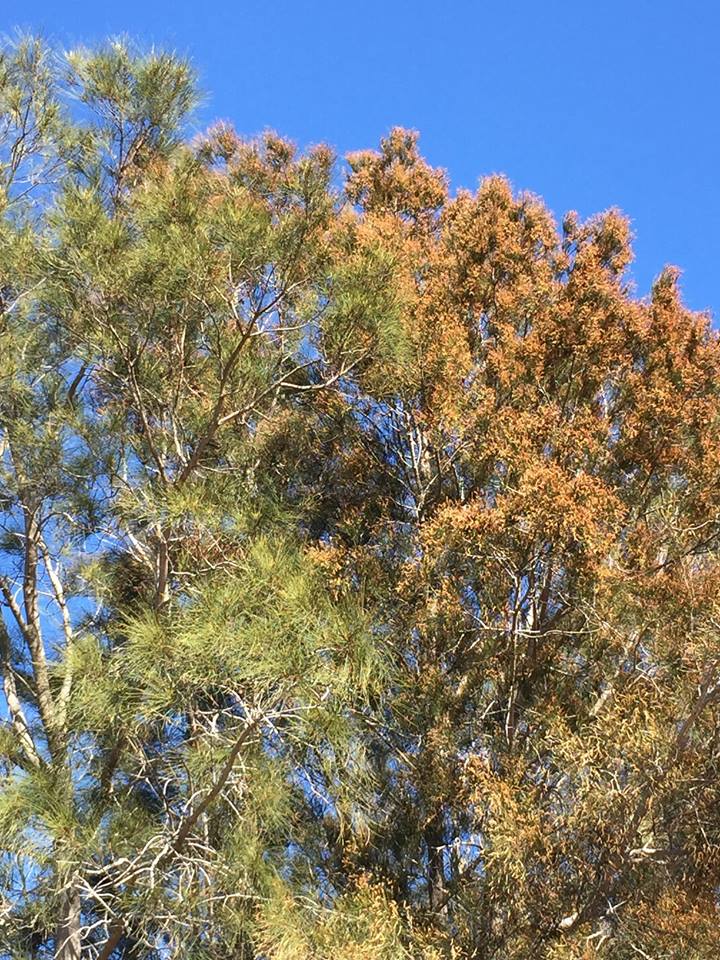
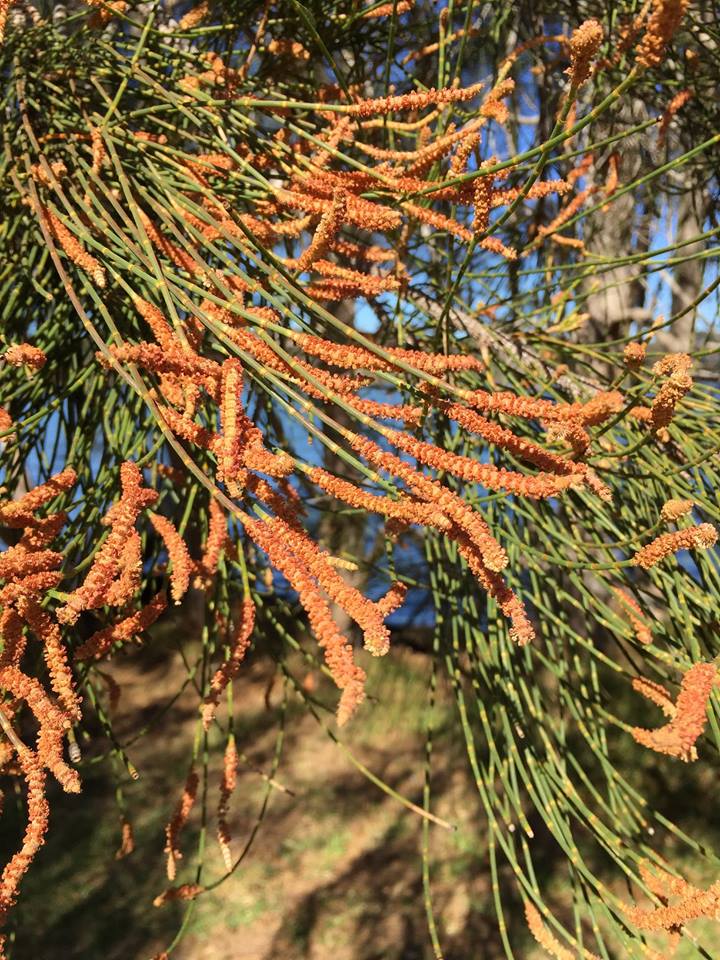
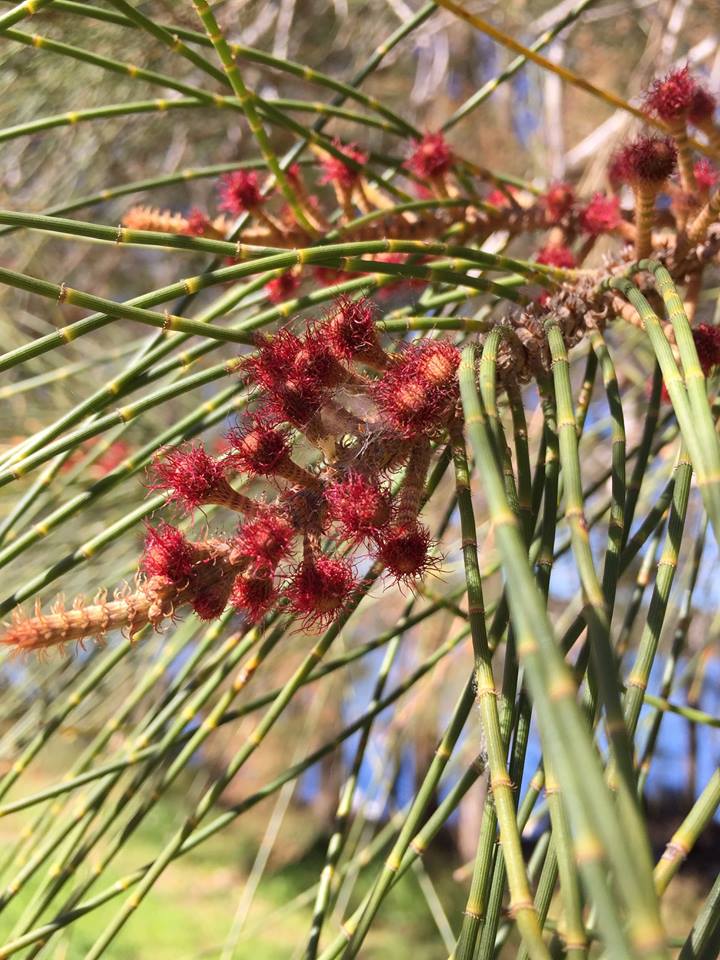
Information and photos by Pittwater Natural Heritage Association (PNHA)
Swamp Oak, Casuarina glauca, trees are either male or female.
Noticed a few brown ones just now? It's not drought, but the millions of rusty flowers of the male trees.
Some of the billions of wind-blown pollen grains land on the hairy red tiny female flowers, which later develop woody capsules containing winged seeds.
These are in Bilarong Reserve.



Information and photos by Pittwater Natural Heritage Association (PNHA)
Swans On Narrabeen Lagoon
Swans feeding on Narrabeen Lagoon 12.9.18, in the little bay where a proposed aquatic walkway could damage their habitat. We are negotiating for a widened onshore track instead. - Pittwater Natural Heritage Association (PNHA).
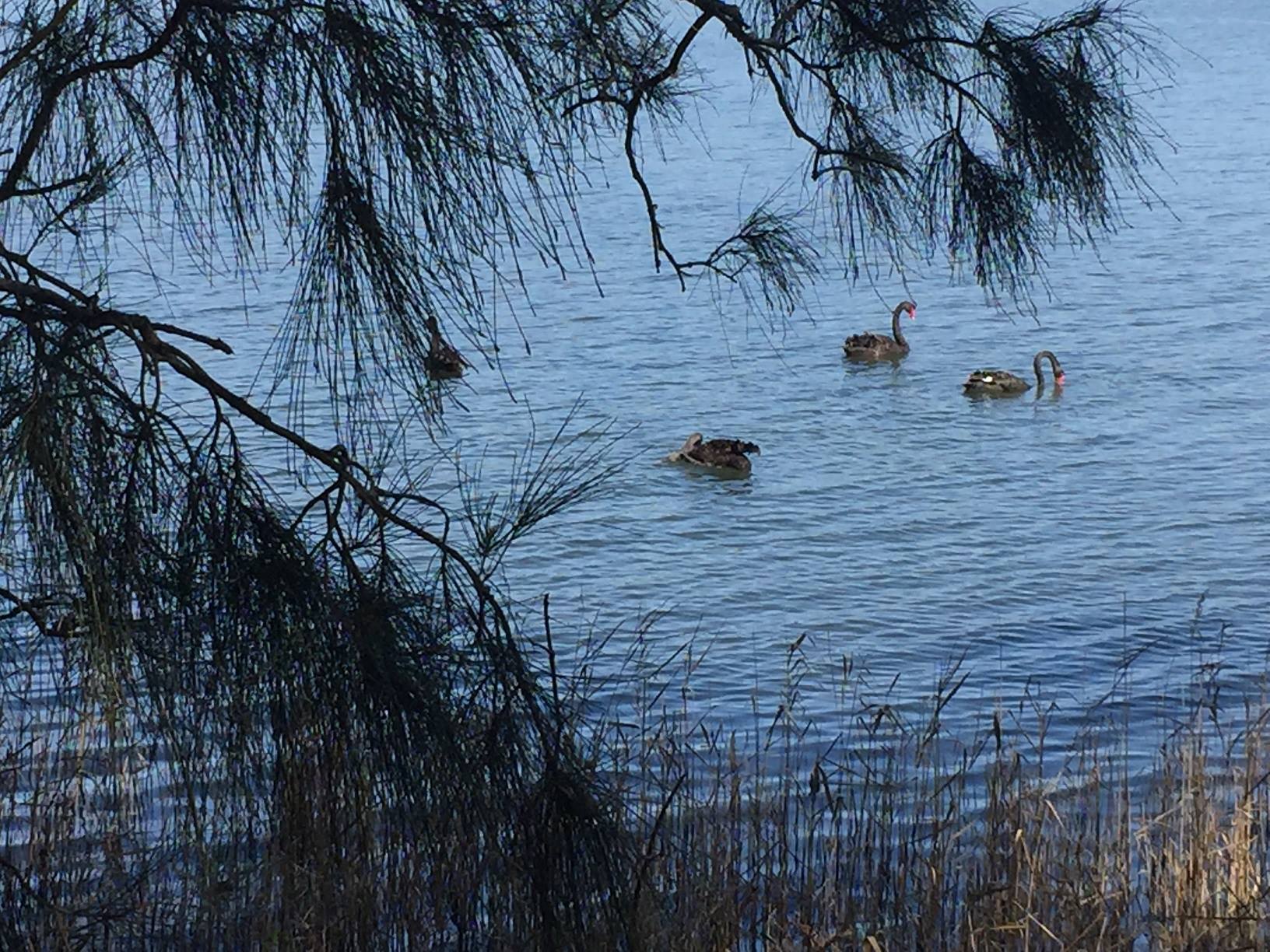
Swans feeding on Narrabeen Lagoon 12.9.18, in the little bay where a proposed aquatic walkway could damage their habitat. We are negotiating for a widened onshore track instead. - Pittwater Natural Heritage Association (PNHA).

Birdlife Along The Careel Creek Corridor
Photographed 15.9.2018 - as the weather begins to warm these watercourses attract more and more birdlife for a swim, a drink and a shady oasis - all provided through years of bush regeneration by bush care volunteers working in conjunction with council - Pittwater Bushcare calendar is listed above - if you rebuild it - they will come!
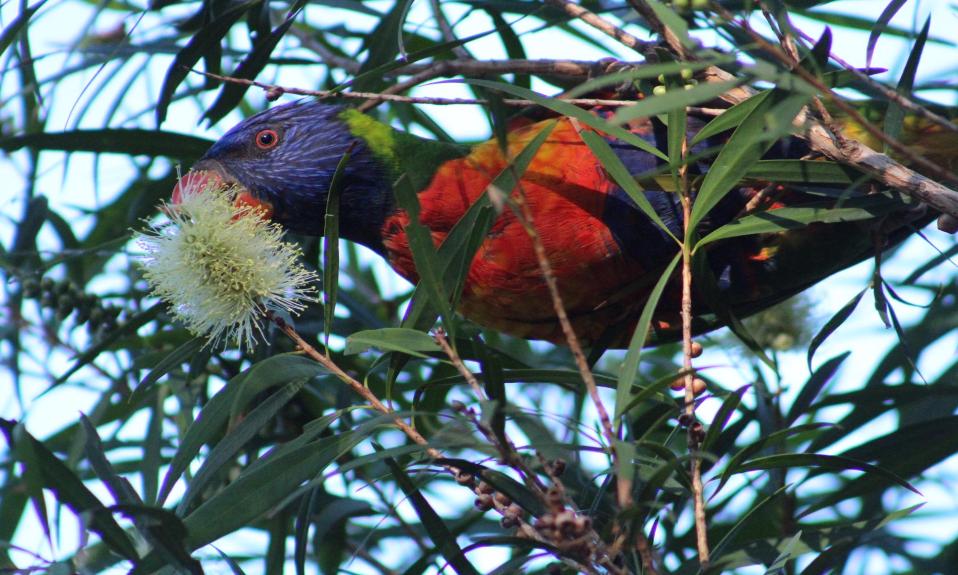 Rainbow Lorikeet Trichoglossus moluccanus feasting on Callistemon salignus White Bottlebrush or Willow Bottlebrush
Rainbow Lorikeet Trichoglossus moluccanus feasting on Callistemon salignus White Bottlebrush or Willow Bottlebrush
.JPG?timestamp=1536977688320)
-640x860.JPG?timestamp=1536977272944)
Australian king parrot Alisterus scapularis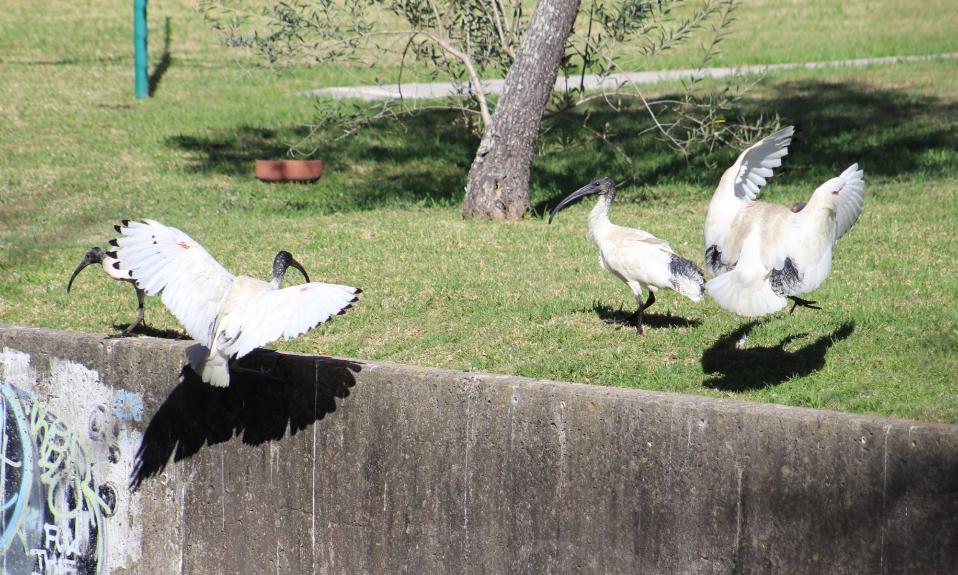 Australian white ibis Threskiornis molucca
Australian white ibis Threskiornis molucca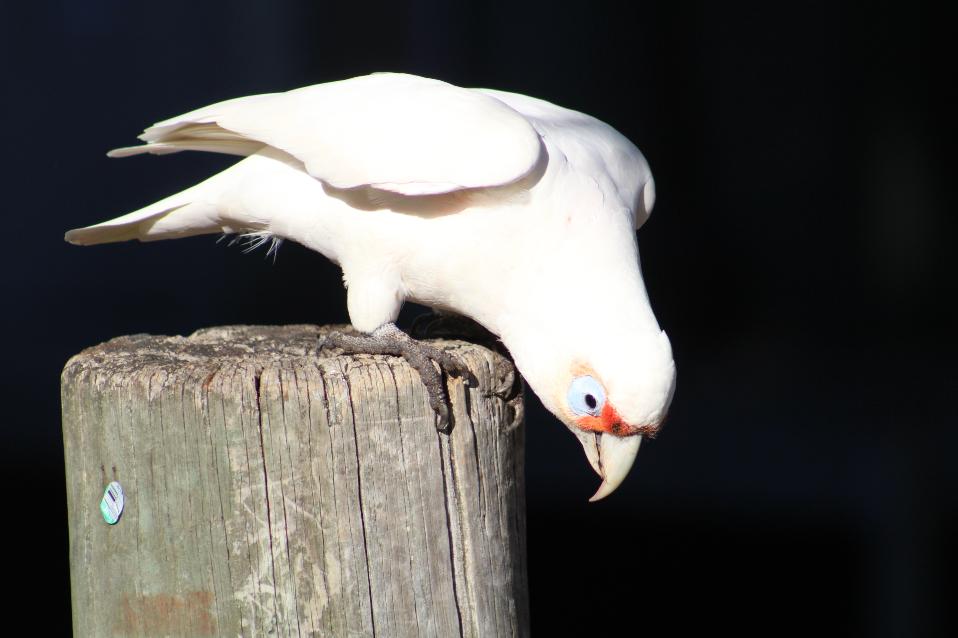 Little Corella Cacatua sanguinea
Little Corella Cacatua sanguinea
Photographed 15.9.2018 - as the weather begins to warm these watercourses attract more and more birdlife for a swim, a drink and a shady oasis - all provided through years of bush regeneration by bush care volunteers working in conjunction with council - Pittwater Bushcare calendar is listed above - if you rebuild it - they will come!
Rainbow Lorikeet Trichoglossus moluccanus feasting on Callistemon salignus White Bottlebrush or Willow Bottlebrush
Australian king parrot Alisterus scapularis
Australian white ibis Threskiornis molucca
Little Corella Cacatua sanguinea
Warming: Peatlands Will Store More Carbon Initially, But That Will Change
September 10, 2018: University of QueenslandPeatlands are extremely effective at storing carbon, but an international study featuring a University of Queensland researcher has found climate change could stop that.
The group investigated how peatlands -- swamps and bogs with organic rich soils -- have responded to climate variability between 850 BCE and 1850 CE.
Associate Professor Patrick Moss, from UQ's School of Earth and Environmental Sciences, believes the research is critical in understanding how climate affects the absorption properties of peatlands.
"Peatlands store between 530 to 694 billion tons of carbon globally," he said.
"So as our world warms, it's important to know how their carbon uptake might change, with possibly big repercussions for the future.
"Carbon is absorbed as peatland plants grow, and eventually turns into peat itself, but at the same time decomposing plants and microbes release it, so it's a fine balance."
The research revealed that the capacity for carbon to build up in peatlands was much higher in temperate regions during warmer periods, but was much less during the same warm periods in the tropics.
"This suggests that carbon accumulation is lower under warmer climate regimes," Associate Professor Moss said.
"This has important ramifications as it suggests that peatland carbon sinks will initially store more carbon -- counteracting warming to some extent -- before switching to releasing more carbon and reinforcing global warming.
"Applying this information to future climate change scenarios suggests that the present day peatland carbon sink will increase slightly until 2100 CE, but then decline."
Associate Professor Moss's observations were made at Moon Point on Fraser Island -the only site in Australia and New Zealand and one of the few in the Southern Hemisphere included in the study.
UQ and the University of Exeter have collaborated on the research and are considering further studies into peatlands and carbon dynamics in Australia, Indonesia and South America.
Angela V. Gallego-Sala, Dan J. Charman, Simon Brewer, Susan E. Page, I. Colin Prentice, Pierre Friedlingstein, Steve Moreton, Matthew J. Amesbury, David W. Beilman, Svante Björck, Tatiana Blyakharchuk, Christopher Bochicchio, Robert K. Booth, Joan Bunbury, Philip Camill, Donna Carless, Rodney A. Chimner, Michael Clifford, Elizabeth Cressey, Colin Courtney-Mustaphi, François De Vleeschouwer, Rixt de Jong, Barbara Fialkiewicz-Koziel, Sarah A. Finkelstein, Michelle Garneau, Esther Githumbi, John Hribjlan, James Holmquist, Paul D. M. Hughes, Chris Jones, Miriam C. Jones, Edgar Karofeld, Eric S. Klein, Ulla Kokfelt, Atte Korhola, Terri Lacourse, Gael Le Roux, Mariusz Lamentowicz, David Large, Martin Lavoie, Julie Loisel, Helen Mackay, Glen M. MacDonald, Markku Makila, Gabriel Magnan, Robert Marchant, Katarzyna Marcisz, Antonio Martínez Cortizas, Charly Massa, Paul Mathijssen, Dmitri Mauquoy, Timothy Mighall, Fraser J. G. Mitchell, Patrick Moss, Jonathan Nichols, Pirita O. Oksanen, Lisa Orme, Maara S. Packalen, Stephen Robinson, Thomas P. Roland, Nicole K. Sanderson, A. Britta K. Sannel, Noemí Silva-Sánchez, Natascha Steinberg, Graeme T. Swindles, T. Edward Turner, Joanna Uglow, Minna Väliranta, Simon van Bellen, Marjolein van der Linden, Bas van Geel, Guoping Wang, Zicheng Yu, Joana Zaragoza-Castells, Yan Zhao. Latitudinal limits to the predicted increase of the peatland carbon sink with warming. Nature Climate Change, 2018; DOI: 10.1038/s41558-018-0271-1
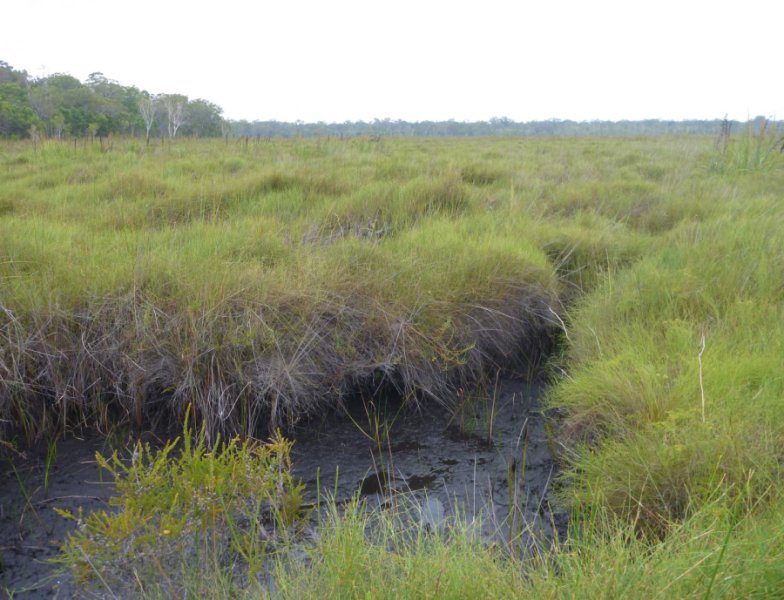
These are the peatlands of Moon Point on Queensland's Fraser Island. Credit: Patrick Moss
September 10, 2018: University of Queensland
Peatlands are extremely effective at storing carbon, but an international study featuring a University of Queensland researcher has found climate change could stop that.
The group investigated how peatlands -- swamps and bogs with organic rich soils -- have responded to climate variability between 850 BCE and 1850 CE.
Associate Professor Patrick Moss, from UQ's School of Earth and Environmental Sciences, believes the research is critical in understanding how climate affects the absorption properties of peatlands.
"Peatlands store between 530 to 694 billion tons of carbon globally," he said.
"So as our world warms, it's important to know how their carbon uptake might change, with possibly big repercussions for the future.
"Carbon is absorbed as peatland plants grow, and eventually turns into peat itself, but at the same time decomposing plants and microbes release it, so it's a fine balance."
The research revealed that the capacity for carbon to build up in peatlands was much higher in temperate regions during warmer periods, but was much less during the same warm periods in the tropics.
"This suggests that carbon accumulation is lower under warmer climate regimes," Associate Professor Moss said.
"This has important ramifications as it suggests that peatland carbon sinks will initially store more carbon -- counteracting warming to some extent -- before switching to releasing more carbon and reinforcing global warming.
"Applying this information to future climate change scenarios suggests that the present day peatland carbon sink will increase slightly until 2100 CE, but then decline."
Associate Professor Moss's observations were made at Moon Point on Fraser Island -the only site in Australia and New Zealand and one of the few in the Southern Hemisphere included in the study.
UQ and the University of Exeter have collaborated on the research and are considering further studies into peatlands and carbon dynamics in Australia, Indonesia and South America.
Angela V. Gallego-Sala, Dan J. Charman, Simon Brewer, Susan E. Page, I. Colin Prentice, Pierre Friedlingstein, Steve Moreton, Matthew J. Amesbury, David W. Beilman, Svante Björck, Tatiana Blyakharchuk, Christopher Bochicchio, Robert K. Booth, Joan Bunbury, Philip Camill, Donna Carless, Rodney A. Chimner, Michael Clifford, Elizabeth Cressey, Colin Courtney-Mustaphi, François De Vleeschouwer, Rixt de Jong, Barbara Fialkiewicz-Koziel, Sarah A. Finkelstein, Michelle Garneau, Esther Githumbi, John Hribjlan, James Holmquist, Paul D. M. Hughes, Chris Jones, Miriam C. Jones, Edgar Karofeld, Eric S. Klein, Ulla Kokfelt, Atte Korhola, Terri Lacourse, Gael Le Roux, Mariusz Lamentowicz, David Large, Martin Lavoie, Julie Loisel, Helen Mackay, Glen M. MacDonald, Markku Makila, Gabriel Magnan, Robert Marchant, Katarzyna Marcisz, Antonio Martínez Cortizas, Charly Massa, Paul Mathijssen, Dmitri Mauquoy, Timothy Mighall, Fraser J. G. Mitchell, Patrick Moss, Jonathan Nichols, Pirita O. Oksanen, Lisa Orme, Maara S. Packalen, Stephen Robinson, Thomas P. Roland, Nicole K. Sanderson, A. Britta K. Sannel, Noemí Silva-Sánchez, Natascha Steinberg, Graeme T. Swindles, T. Edward Turner, Joanna Uglow, Minna Väliranta, Simon van Bellen, Marjolein van der Linden, Bas van Geel, Guoping Wang, Zicheng Yu, Joana Zaragoza-Castells, Yan Zhao. Latitudinal limits to the predicted increase of the peatland carbon sink with warming. Nature Climate Change, 2018; DOI: 10.1038/s41558-018-0271-1

These are the peatlands of Moon Point on Queensland's Fraser Island. Credit: Patrick Moss
Australian Fur Seal Pup Population Is Shrinking
September 2018A census of annual pup production by Australian fur seal populations revealed the first reduction since species-wide protection was implemented in 1975, according to a study published September 5 in the open-access journal PLOS ONE by Rebecca McIntosh of the Phillip Island Nature Parks in Victoria, Australia, and colleagues. The study also shows that the long-term monitoring program for the Australian fur seal has effectively tracked population trends over time.
In the marine environment, monitoring the abundance and population trends of a top predator can provide measures of ecosystem health and management success. Fur seals, Arctocephalus pusillus doriferus, are important upper trophic level predators that, in Australia, are a protected marine species facing specific challenges related to fisheries and aquaculture management, ecotourism, potential impacts on seabirds, and response planning for oil spills and other emergencies. For these reasons, it is important to obtain accurate information about their abundance and population changes. An ad-hoc monitoring program coordinated across multiple stakeholders conducted a range-wide census of live pups in the Austral summers of 2002, 2007 and 2013. In the new study, McIntosh and colleagues set out to assess whether the monitoring program for the Australian fur seal is achieving its goals of determining pup abundance and estimating population trends.
The findings reveal that monitoring of the Australian fur seal between the 1970s and 2013 has effectively recorded population changes. The census successfully tracked signs of population recovery up to 2007. In addition, the 2013 census identified the first pup population decline, estimated to be 4.2% per year since 2007, since species-wide protection was implemented. According to the authors, the study highlights the importance of regularly assessing long-term monitoring programs and provides valuable information on how to effectively design and improve these programs.
Roland Pick, of Phillip Island Nature Parks, notes: "As wildlife managers it is important for us to regularly review our monitoring programs to examine the reliability of the information we have collected, and also to identify enhancements which may assist in a greater understanding of any population changes detected. We are currently using drone technology and Citizen Science programs at Phillip Island Nature Parks to enhance our monitoring of Seal Rocks as the largest breeding colony for the species."
Rebecca R. McIntosh, Steve P. Kirkman, Sam Thalmann, Duncan R. Sutherland, Anthony Mitchell, John P. Y. Arnould, Marcus Salton, David J. Slip, Peter Dann, Roger Kirkwood. Understanding meta-population trends of the Australian fur seal, with insights for adaptive monitoring. PLOS ONE, 2018; 13 (9): e0200253 DOI: 10.1371/journal.pone.0200253
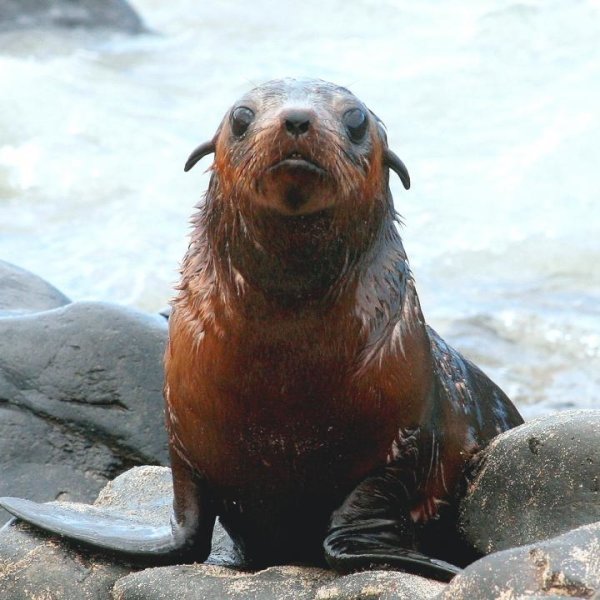
Fur seal pup. Credit: Phillip Island Nature Parks, CC-BY
September 2018
A census of annual pup production by Australian fur seal populations revealed the first reduction since species-wide protection was implemented in 1975, according to a study published September 5 in the open-access journal PLOS ONE by Rebecca McIntosh of the Phillip Island Nature Parks in Victoria, Australia, and colleagues. The study also shows that the long-term monitoring program for the Australian fur seal has effectively tracked population trends over time.
In the marine environment, monitoring the abundance and population trends of a top predator can provide measures of ecosystem health and management success. Fur seals, Arctocephalus pusillus doriferus, are important upper trophic level predators that, in Australia, are a protected marine species facing specific challenges related to fisheries and aquaculture management, ecotourism, potential impacts on seabirds, and response planning for oil spills and other emergencies. For these reasons, it is important to obtain accurate information about their abundance and population changes. An ad-hoc monitoring program coordinated across multiple stakeholders conducted a range-wide census of live pups in the Austral summers of 2002, 2007 and 2013. In the new study, McIntosh and colleagues set out to assess whether the monitoring program for the Australian fur seal is achieving its goals of determining pup abundance and estimating population trends.
The findings reveal that monitoring of the Australian fur seal between the 1970s and 2013 has effectively recorded population changes. The census successfully tracked signs of population recovery up to 2007. In addition, the 2013 census identified the first pup population decline, estimated to be 4.2% per year since 2007, since species-wide protection was implemented. According to the authors, the study highlights the importance of regularly assessing long-term monitoring programs and provides valuable information on how to effectively design and improve these programs.
Roland Pick, of Phillip Island Nature Parks, notes: "As wildlife managers it is important for us to regularly review our monitoring programs to examine the reliability of the information we have collected, and also to identify enhancements which may assist in a greater understanding of any population changes detected. We are currently using drone technology and Citizen Science programs at Phillip Island Nature Parks to enhance our monitoring of Seal Rocks as the largest breeding colony for the species."
Rebecca R. McIntosh, Steve P. Kirkman, Sam Thalmann, Duncan R. Sutherland, Anthony Mitchell, John P. Y. Arnould, Marcus Salton, David J. Slip, Peter Dann, Roger Kirkwood. Understanding meta-population trends of the Australian fur seal, with insights for adaptive monitoring. PLOS ONE, 2018; 13 (9): e0200253 DOI: 10.1371/journal.pone.0200253

Fur seal pup. Credit: Phillip Island Nature Parks, CC-BY
Global Coastal Wetlands Need To Move Inland In Fight Against Climate Change
September 12, 2018: University of LincolnUp to 30 per cent of coastal wetlands could be lost globally by the year 2100 with a dramatic effect on global warming and coastal flooding, if action is not taken to protect them, new research warns.
The global study, led by researchers at the University of Lincoln, UK, suggests that the future of global coastal wetlands, including tidal marshes and mangroves, could be secured if they were able to migrate further inland.
Geographers examined localised data from around the globe on coastal elevation, tides, sediment availability, coastal population and estimates of sea level rise to assess whether coastal wetlands are likely to have enough sediment to increase their elevation at the rate sea levels will rise, or whether there is enough space to establish themselves further inland.
The results show there could be global coastal wetland gains of up to 60 per cent if more than a third of the areas had space to move inland. The use of more localised data provides more accurate global results than previous estimates which warned of catastrophic losses of up to 90 per cent -- but scientists say action must be taken now to save coastal wetlands from ever increasing sea levels.
The findings of the study have important implications for the future development of public policies, with the authors calling for an upscale in current efforts for coastal wetland restoration.
Coastal wetlands have a direct impact on global warming levels by helping to remove carbon dioxide from the atmosphere. They are also an important form of coastal protection, reducing the energy of waves and the intensity of storm surges, thereby reducing coastal erosion and coastal flooding.
The research was led by Dr Mark Schuerch from the University of Lincoln's School of Geography in collaboration with the universities of Cambridge and Southampton in the UK; University of Antwerp in Belgium; Christian-Albrechts University of Kiel and Humboldt-University in Germany; Monash University in Australia; Virginia Institute of Marine Science in the USA; the UN Environment World Conservation Monitoring Centre; and the Global Climate Forum.
Dr Schuerch said: "Rather than being an inevitable consequence of global rising sea levels, our findings indicate that large-scale coastal wetland loss might be avoidable if sufficient additional space can be created by increasing the number of innovative 'nature-based adaptation' solutions to coastal management. These enable coastal wetlands to migrate inland through displacement of coastal flood defences and the designation of nature reserve buffers in upland areas surrounding coastal wetlands. If these are strategically scaled up they could help coastal wetlands adapt to rising sea levels and protect rapidly increasing global coastal populations."
Further research is now needed to improve understanding of the adaption mechanisms of coastal wetlands to see level rise, particularly their ability to migrate inland.
Mark Schuerch, Tom Spencer, Stijn Temmerman, Matthew L. Kirwan, Claudia Wolff, Daniel Lincke, Chris J. McOwen, Mark D. Pickering, Ruth Reef, Athanasios T. Vafeidis, Jochen Hinkel, Robert J. Nicholls, Sally Brown. Future response of global coastal wetlands to sea-level rise. Nature, 2018; 561 (7722): 231 DOI: 10.1038/s41586-018-0476-5
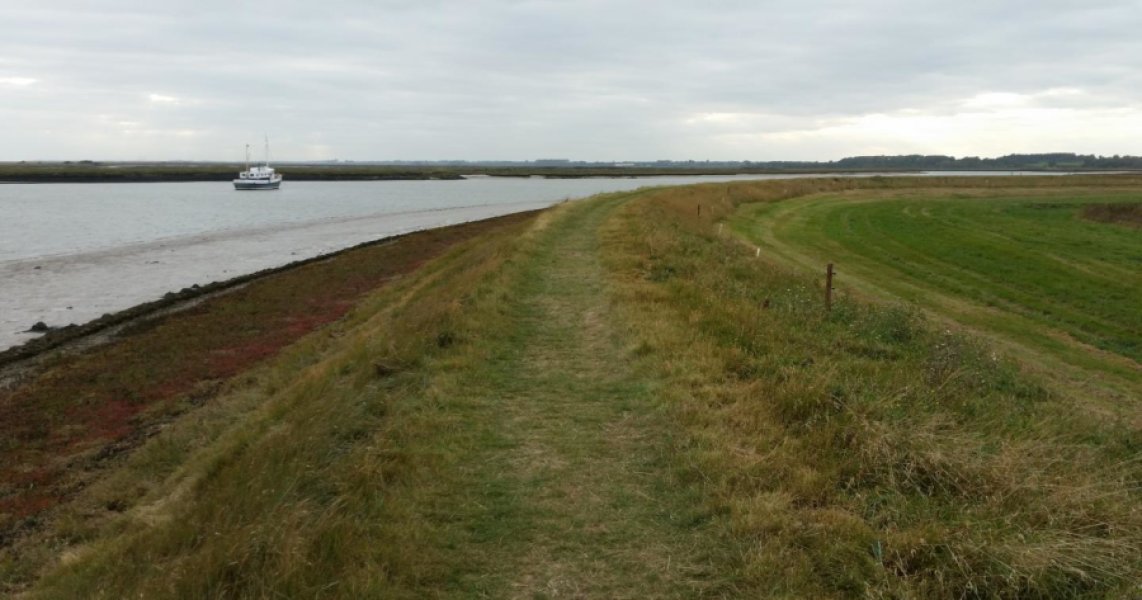
A narrow strip of coastal salt marsh on the UK east coast (near Orford, Suffolk) where inland migration is inhibited by the presence of a sea dike. Global sea level rise will further squeeze this salt marsh and eventually drown it, unless additional accommodation space is created for the marsh to migrate inland. Credit: University of Lincoln
September 12, 2018: University of Lincoln
Up to 30 per cent of coastal wetlands could be lost globally by the year 2100 with a dramatic effect on global warming and coastal flooding, if action is not taken to protect them, new research warns.
The global study, led by researchers at the University of Lincoln, UK, suggests that the future of global coastal wetlands, including tidal marshes and mangroves, could be secured if they were able to migrate further inland.
Geographers examined localised data from around the globe on coastal elevation, tides, sediment availability, coastal population and estimates of sea level rise to assess whether coastal wetlands are likely to have enough sediment to increase their elevation at the rate sea levels will rise, or whether there is enough space to establish themselves further inland.
The results show there could be global coastal wetland gains of up to 60 per cent if more than a third of the areas had space to move inland. The use of more localised data provides more accurate global results than previous estimates which warned of catastrophic losses of up to 90 per cent -- but scientists say action must be taken now to save coastal wetlands from ever increasing sea levels.
The findings of the study have important implications for the future development of public policies, with the authors calling for an upscale in current efforts for coastal wetland restoration.
Coastal wetlands have a direct impact on global warming levels by helping to remove carbon dioxide from the atmosphere. They are also an important form of coastal protection, reducing the energy of waves and the intensity of storm surges, thereby reducing coastal erosion and coastal flooding.
The research was led by Dr Mark Schuerch from the University of Lincoln's School of Geography in collaboration with the universities of Cambridge and Southampton in the UK; University of Antwerp in Belgium; Christian-Albrechts University of Kiel and Humboldt-University in Germany; Monash University in Australia; Virginia Institute of Marine Science in the USA; the UN Environment World Conservation Monitoring Centre; and the Global Climate Forum.
Dr Schuerch said: "Rather than being an inevitable consequence of global rising sea levels, our findings indicate that large-scale coastal wetland loss might be avoidable if sufficient additional space can be created by increasing the number of innovative 'nature-based adaptation' solutions to coastal management. These enable coastal wetlands to migrate inland through displacement of coastal flood defences and the designation of nature reserve buffers in upland areas surrounding coastal wetlands. If these are strategically scaled up they could help coastal wetlands adapt to rising sea levels and protect rapidly increasing global coastal populations."
Further research is now needed to improve understanding of the adaption mechanisms of coastal wetlands to see level rise, particularly their ability to migrate inland.
Mark Schuerch, Tom Spencer, Stijn Temmerman, Matthew L. Kirwan, Claudia Wolff, Daniel Lincke, Chris J. McOwen, Mark D. Pickering, Ruth Reef, Athanasios T. Vafeidis, Jochen Hinkel, Robert J. Nicholls, Sally Brown. Future response of global coastal wetlands to sea-level rise. Nature, 2018; 561 (7722): 231 DOI: 10.1038/s41586-018-0476-5

A narrow strip of coastal salt marsh on the UK east coast (near Orford, Suffolk) where inland migration is inhibited by the presence of a sea dike. Global sea level rise will further squeeze this salt marsh and eventually drown it, unless additional accommodation space is created for the marsh to migrate inland. Credit: University of Lincoln
Breakthrough In Schizophrenia Identifies Importance Of Immune Cells
September 13, 2018: NEURA/UNSW
Researchers from NeuRA and UNSW have made a major discovery in schizophrenia research that could open doors to new treatments, research and therapies.
In one of the biggest breakthroughs in schizophrenia research in recent times, Professor Cynthia Shannon Weickert from Neuroscience Research Australia (NeuRA) and UNSW Sydney has identified immune cells in greater amounts in the brains of some people with schizophrenia.
The study, published in Molecular Psychiatry, has the potential to transform global schizophrenia research and open new avenues for developing targeted immune cell therapies.
One in every 100 Australians lives with schizophrenia. No single cause of schizophrenia has been identified, and this has prevented the development of a cure. The current treatments for schizophrenia are designed to suppress symptoms rather than target underlying causes of the disorder. These drugs only partially relieve symptoms and can produce unwanted side effects.
Most scientists have had a long held belief that immune cells were independent from the brain pathology in psychotic illnesses, said Professor Shannon Weickert, who is the chair of NSW Chair of Schizophrenia Research based at NeuRA and the School of Psychiatry, UNSW.
“In our study, we challenged this assumption that immune cells were independent of the brain in psychiatric illness and made an exciting discovery. We identified immune cells as a new player in the brain pathology of schizophrenia,” said Professor Shannon Weickert.
Current schizophrenia research has focused on the status of three brain cells: the neurons; the glial cells, which support the neurons; and the endothelial cells, which coat the blood vessels. Employing new molecular techniques allowed Professor Shannon Weickert and her team to identify the presence of a fourth cell, the macrophage, a type of immune cell in the brain tissue of people with schizophrenia who show high levels of inflammation.
“Immune cells have previously been ignored as they had long been viewed simply as travelers just thought to be passing by, undertaking surveillance work. They have never been a suspect until now,” said Professor Shannon Weickert.
“To find immune cells along the blood brain barrier in increased amounts in people with schizophrenia is an exciting discovery. It suggests immune cells themselves may be producing these inflammatory signals in the brains of people living with schizophrenia.”
“We have observed in people with schizophrenia, the glial cells, one of the local residents, become inflamed and produce distress signals which change the status of the endothelial cells.
“We think this may cause the endothelial cells to extend sticky tentacles, so when the immune cells travel by some are captured. These cells may transmigrate across the blood brain barrier entering the brain in greater amounts in some people with schizophrenia compared to people without the disorder,” said Professor Shannon Weickert.
This discovery shows that specific immune cells are in the brains of some people with schizophrenia in close enough proximity to the neurons to do damage.
Professor Peter Schofield, CEO of NeuRA, said this innovative new research has the ability to possibly alter the diagnosis and treatment schizophrenia.
"This breakthrough demonstrates the value of the NSW Government's support for Professor Shannon Weickert as NSW Chair of Schizophrenia Research, which has delivered new insights that the community seeks," said Professor Schofield.
Professor Shannon Weickert is encouraging a cross-collaborative approach between neuroscientists and immunologists globally, to work together to develop treatments targeting this abnormal immune pathology of schizophrenia.
"This opens whole new avenues for therapy, because it suggests that the pathology of schizophrenia could be within the immune cells and the immune cells could be contributing to the symptoms of schizophrenia,” said Professor Shannon Weickert.
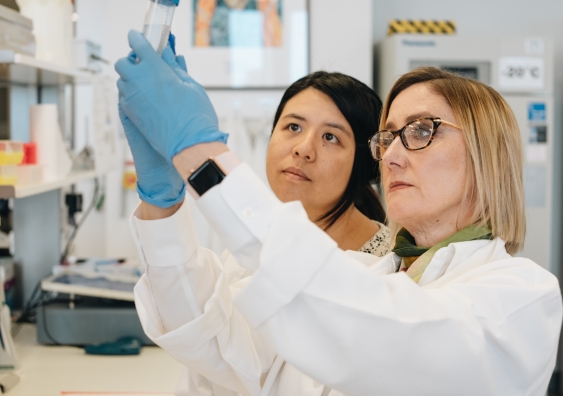
NeuRA and UNSW Professor Cynthia Shannon Weickert and NeuRA PhD student Helen Cai. Photo: NeuRA
World-Class Care Despite Rising Demand
September 12, 2018: NSW Health
Patients at public hospitals across NSW continue to receive excellent care, despite record numbers of people presenting to emergency departments.
The BHI Hospital Quarterly, April to June 2018, showed emergency department and elective surgery performance remained at a high level in the face of increasing demand.
NSW Health Executive Director Ray Messom said more than three-quarters (76.6 per cent) of NSW patients were being seen within clinically recommended timeframes, despite an increase of 8,562 presentations.
“The percentage of patients who spent four hours or less in the ED also improved to almost three-quarters (74 per cent).
“Over 157,000 patients arrived by ambulance to an emergency department in the April to June quarter and, of these, nearly 92 per cent were transferred from paramedics to hospital clinicians within 30 minutes.”
Mr Messom said for the second quarter in a row, Western Sydney public hospitals in particular showed significant improvements in performance.
“Despite 47,300 people presenting to Western Sydney emergency departments this quarter, an increase of 1,731 patients, once again Blacktown, Westmead, and Mount Druitt improvements were outstanding,” Mr Messom said.
Overall, 97 per cent of elective surgical procedures were performed within clinically recommended timeframes, with 1295 more elective surgeries performed when compared with the same quarter the previous year.
In 2018-19, the NSW Government is investing a record $22.9 billion in health, representing a $1.1 billion increase over the 2017-18 Budget. This includes $19.2 billion towards improving services in hospitals in NSW this year.
An investment of $759 million for acute patient services will fund an additional 40,000 emergency department attendances in addition to 2.9 million already provided and an extra 3,200 elective surgeries in addition to the 225,500 already provided.
The NSW Government’s record $1 billion 2018-19 NSW Ambulance budget includes a commitment to provide an additional 700 paramedics and 50 Triple Zero control centre staff over the next four years.
The 2018-19 Budget also added 1,370 health staff, including 950 nurses and midwives,
300 medical practitioners and 120 allied health professionals – resulting in a record frontline clinical and clinical support staff of over 105,000.
Help Us Recognise 'The Dish' That Put A Town On The Map
September 13, 2018: Media release - The Hon. Melissa Price MP, Minister for the Environment
I'm pleased to announce the famous Parkes Observatory - or to most of us - the Dish 'in the middle of the sheep paddock', is one of two new places being assessed for inclusion on our National Heritage List.
The Australian Heritage Council will conduct National Heritage assessments of Parkes Observatory in New South Wales and Yalangbara in the Northern Territory.
Each year the Australian Government puts out a call to add sites of outstanding national significance to our heritage register.
All Australians will have the opportunity to give their feedback on heritage listing of these sites.
Parkes Observatory in central-west NSW is best known for the pivotal role it played in transmitting images of the Apollo II moon landing to the world in 1969.
Since it was built, more than 50 years ago, it has showcased Australia's scientific ingenuity and expanded our knowledge of the universe.
Established in the pioneering years of radio astronomy, the Observatory's radio telescope was one of the first built as a movable dish. It served as a prototype for other telescopes around the world and contributed to major scientific advances such as the discovery of quasars - celestial objects which helped support the Big Bang theory.
Yalangbara, home to Yolngu traditional owners, stretches over 210 square kilometres of sand dunes, rocky outcrops and coastal waters, including Lalawuy Bay (Port Bradshaw) in north-east Arnhem Land. This region is central to the foundation story of the Dhuwa group and culture. Wapilina Island is known for its early interactions with Macassan fishers from Indonesia who visited before European settlement.
The Yolngu are also known for their Aboriginal activism, through the Gove court case - the first Native Title land rights application and the Carpets court case, which was brought to protect the intellectual property rights of Aboriginal artists from the unauthorised reproduction traditional Aboriginal designs.
Working Together On World Suicide Prevention Day
September 10, 2018: Minister for Mental Health, The Hon. Tanya Davies
Accurately and respectfully talking about suicide and encouraging people to seek help is in the spotlight today on World Suicide Prevention Day, as NSW becomes the first state or territory government to sign the new National Charter, which aims to prevent suicide.
Minister for Mental Health Tanya Davies said the signing of The National Communications Charter: A unified approach to mental health and suicide prevention is an important way the NSW Government can encourage safe discussions about suicide.
“When talking about mental health or suicide, we all have a responsibility - individuals, businesses, media and governments - to communicate in ways that are safe,” Mrs Davies said.
“Lives can be saved by engaging and having the right conversations with someone that may need help. The most important message is that there is help available and we should empower people to take action and get support.”
The new Charter, available online and developed by Everymind, gives practical guidance around language and how to support a friend, family member, colleague or even a stranger, that may be experiencing a mental health issue.
The latest figures from the Australian Bureau of Statistics show the NSW suicide rate is below the national average, with 805 deaths by suicide in 2016, down from 815 the year before.
“Suicide prevention is everybody’s business and there is still much work to do which is why the NSW Government and the Mental Health Commission of NSW are working together with communities across the State on a much-needed suicide prevention framework.”
The 2018-19 NSW Budget delivered a record investment of $2.1 billion for mental health services and $700 million for infrastructure.
For more information on how to participate in World Suicide Prevention Day today visit www.wspd.org.au. To read or sign the Charter go to www.lifeinmindaustralia.com.au/the-charter.
If you or someone you know needs crisis support, phone Lifeline on 13 11 14. For mental health services in your local area call the NSW Mental Health Line 1800 011 511.
Sydney Metro Stations To Be Fully Accessible
September 11, 2018: NSW Government
Lifts and escalators have been purchased to make Sydney Metro a fully accessible railway for people in wheelchairs, parents with prams and those who are less able.
Approximately 70 lifts and 130 escalators will be installed on the Sydney Metro from Chatswood into the city and beyond to the south-west.
Accessibility upgrades will include:
- New lifts and escalators for the six new metro railway stations at Crows Nest, Victoria Cross, Barangaroo, Martin Place, Pitt Street and Waterloo.
- Lifts and escalators to provide direct access to Central Walk from the underground Central Station metro platforms.
- New escalators from the new underground Central Walk concourse to platforms 12-23 at Central Station.
The upgrade of the Bankstown line to metro standards means all 11 stations between Sydenham and Bankstown will have lifts – including Punchbowl, Wiley Park, Canterbury, Hurlstone Park and Dulwich Hill.
Each metro train has two wheelchair spaces per carriage, as well as dedicated priority seating for those less able. Each train also has two multi-purpose areas for prams, luggage and bicycles.
Sydney Metro is Australia’s first fully automated railway, and will feature the country’s first platform screen doors. These will keep people and objects away from the tracks and allow trains to get in and out of stations much faster.
Minister for Transport and Infrastructure Andrew Constance said there will be more choice for people in how they get around Sydney.
“We’re building this unprecedented project mostly deep underground, and we need this infrastructure to get customers to these fully-accessible stations,” said Mr Constance.
Sydney Metro will open in the city’s north-west in early 2019.
Tiny Camera Lens May Help Link Quantum Computers To Network
September 13, 2018: Australian National University
An international team of researchers led by The Australian National University (ANU) has invented a tiny camera lens, which may lead to a device that links quantum computers to an optical fibre network.
Quantum computers promise a new era in ultra-secure networks, artificial intelligence and therapeutic drugs, and will be able to solve certain problems much faster than today's computers.
The unconventional lens, which is 100 times thinner than a human hair, could enable a fast and reliable transfer of quantum information from the new-age computers to a network, once these technologies are fully realised.
The device is made of a silicon film with millions of nano-structures forming a metasurface, which can control light with functionalities outperforming traditional systems.
Associate Professor Andrey Sukhorukov said the metasurface camera lens was highly transparent, thereby enabling efficient transmission and detection of information encoded in quantum light.
"It is the first of its kind to image several quantum particles of light at once, enabling the observation of their spooky behaviour with ultra-sensitive cameras," said Associate Professor Sukhorukov, who led the research with a team of scientists at the Nonlinear Physics Centre of the ANU Research School of Physics and Engineering.
Kai Wang, a PhD scholar at the Nonlinear Physics Centre who worked on all aspects of the project, said one challenge was making portable quantum technologies.
"Our device offers a compact, integrated and stable solution for manipulating quantum light. It is fabricated with a similar kind of manufacturing technique used by Intel and NVIDIA for computer chips." he said.
The research was conducted at the Nonlinear Physics Centre laboratories, where staff and postgraduate scholars developed and trialled the metasurface camera lens in collaboration with researchers at the Oak Ridge National Laboratory in the United States and the National Central University in Taiwan.
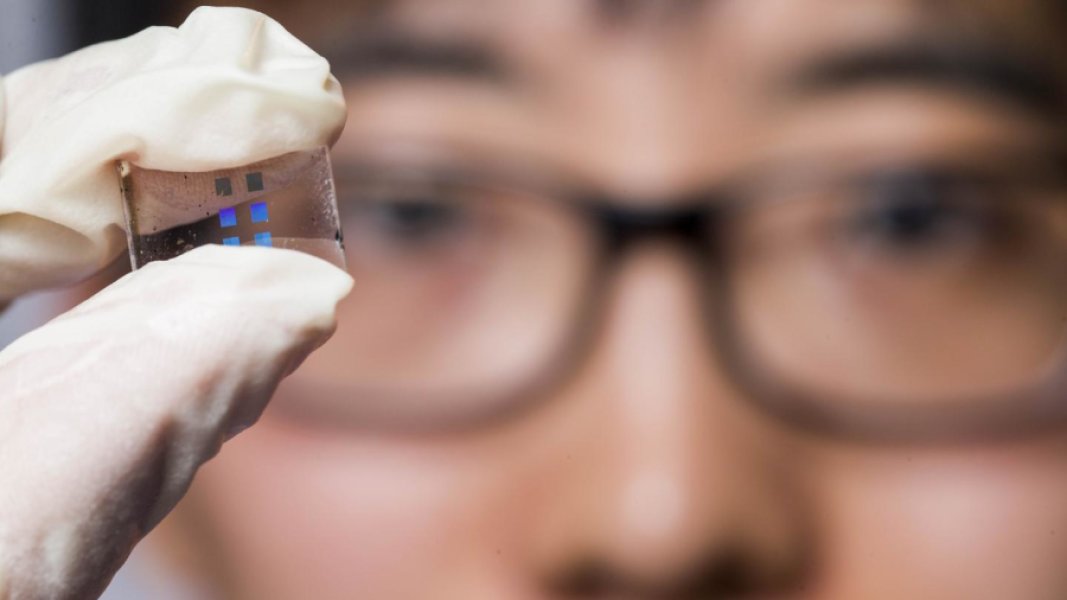
Kai Wang holding a sample that has multiple metasurface camera lenses. Credit: Lannon Harley, ANU
Kai Wang, James G. Titchener, Sergey S. Kruk, Lei Xu, Hung-Pin Chung, Matthew Parry, Ivan I. Kravchenko, Yen-Hung Chen, Alexander S. Solntsev, Yuri S. Kivshar, Dragomir N. Neshev, Andrey A. Sukhorukov. Quantum metasurface for multiphoton interference and state reconstruction. Science, 2018; 361 (6407): 1104-1108 DOI: http://dx.doi.org/10.1126/science.aat8196
Koalas Are Thirsty For Your Help
Rising temperatures and drought are drying up eucalyptus leaves, the only source of hydration and nutrition for Australia’s iconic animal, the koala. They’re now searching for water to avoid fatal heat stress.
That’s why on 18 September 2018, the University of Sydney community will come together to Pave the Way for a brighter future for our koalas. We are fundraising to install drinking stations to give them access to water they so desperately need.
Find out more and make a donation: http://www.sydney.edu.au/pavetheway
Figures Show NSW Public Hospitals Overloaded
Wednesday September 12th
from NSW Nurses and Midwives’ Association
Emergency Department presentations and patient acuity is on the rise across NSW public hospitals, according to the latest Bureau of Health Information (BHI) quarterly report.
Results released today indicate an increase in emergency presentations across 11 of the 15 local health districts across the state during April to June this year. The figures highlight the ongoing strain on our public hospitals and the need for a new nurse-to-patient ratios system to manage consistent demand.
Some of the busiest hospitals include Queanbeyan Hospital, which experienced a 13.4% increase in Emergency Department (ED) presentations compared to the same time last year and Blacktown Hospital, which recorded a 7.3% increase in its ED figures and 20% rise in hospital admissions from the emergency department.
NSW Nurses and Midwives’ Association (NSWNMA) General Secretary, Brett Holmes said the year-on-year pressure on our public hospitals was taking a toll on nurses and midwives.
“We know presentations are rising, yet nurses and midwives are taking on that increased workload. It’s unsustainable to rely on a staffing model that we now know is being manipulated to save costs.”
During a data capturing exercise, the NSWNMA uncovered 38,033 hours of missed clinical nursing care in 2017 due to non-compliance with the current Nursing Hours per Patient Day (NHPPD) system.
“The current system is not working. There are no minimum standards for nurse to patient ratios in Emergency Departments and children’s wards and the number of nurses can be averaged over the week with no mandated ratio for every shift. We need a new reliable shift-by-shift ratios system to provide a clear understanding of how many patients nurses have to care for,” Mr Holmes said.
City hospitals experiencing considerable increases in ED presentations include Prince of Wales (5.4%); Campbelltown Hospital (6.7%); Liverpool Hospital (6.9%); Wollongong Hospital (7.2%) and Royal Prince Alfred Hospital (4.6%) combined with a 10.2% increase in admissions to the hospital from its ED.
In the regions Cooma (7.6%); Goulburn (8.5%) and Wagga Wagga (6.5%) reported significant increases in ED treatments.
“Our regional hospitals are experiencing a higher volume of patients, yet they receive less nursing hours per patient than city hospitals. It’s not right that a patient’s postcode can determine their level of care,” Mr Holmes said.
The NSWNMA is campaigning for mandated nurse-to-patient ratios in every ward, on every shift across all major and district NSW hospitals.
Display of Final Preliminary Documentation for Mt Gilead Residential Development, Gilead, NSW (EPBC 2015/7599)
Date of Notice: 6/9/2018
The following notice is published pursuant to Section 95B(2) of the Environment Protection and Biodiversity Conservation Act 1999 (EPBC Act).
Lendlease Communities (Mt Gilead) Pty Limited is proposing to construct a residential development at Gilead, NSW. The overall development will be for residential land use and is planned to consist of residential dwellings, with an indicative yield of approximately 1,700 lots, associated infrastructure, community centre and small kiosk/store, parkland, open space and biodiversity offset and environmental conservation areas.
The proposed action has been determined to be a “controlled action” under the EPBC Act. The controlling provision under the EPBC Act is “Listed threatened species and communities” (Sections 18 and 18A).
The Commonwealth Department of the Environment and Energy advised that the project will be assessed through Preliminary Documentation.
On 20 December 2017, the draft preliminary documentation was placed on public exhibition until 2 February (30 business days). During this period, twenty-four submissions were received. A document summarising and responding to the comments has now been prepared and the preliminary documentation finalised to respond, where required, to the submissions. The documents can be viewed and/or downloaded at:http://www.ecoaus.com.au/notices/MtGileadEPBC
The final documentation can be viewed at the following locations for 10 days from the 5th to 19th of September 2018: Campbelltown City Library – 1 Hurley Street, Campbelltown NSW 2560
State Library of NSW – Macquarie St, Sydney NSW 2000
Persons with special needs (i.e. for whom English is a second language or who have a vision impairment) may contact Robert Humphries on 02 8536 8620 for assistance in accessing the documentation in digital (CD) format
Mt Gilead Residential Development
EPBC Preliminary Documentation Assessment Report (EPBC 2015/7599)
Prepared for:
Lendlease Communities (Mt Gilead) Pty Ltd
27 August 2018
Koalas In NSW Are Losing Their Homes
They’re losing their homes to excessive tree-clearing and if we don’t act soon, koalas could be extinct in NSW as early as 2050. Due to weakened laws, tree-clearing has tripled in the past two years, resulting in the destruction of the homes of more than 240 native species.
Sign the petition: https://wwfau.org/2NUAaLP
Koala Habitat Destruction Triples After NSW Protection Axed: 14ha Of Koala Habitat Bulldozed Each Day
September 7, 2018Satellite imagery shows a massive spike in the destruction of NSW koala forests, with the rate of tree clearing tripling in the state’s north since the axing of the NSW Native Vegetation Act in August 2017.
Following the removal of laws protecting koala forests, more than 5,000 hectares of koala habitat has been bulldozed in the NSW districts of Moree and Collarenebri at a rate of about 14 football fields a day, a new report by WWF-Australia and the NSW Nature Conservation Council has found.
REPORT HIGHLIGHTSSince the repeal of the NSW Native Vegetation Act, in the Moree-Collarenebri region:- Clearing almost tripled. 8,194 ha was cleared in 2017-18, up from 2,845ha in 2016-17. See Table 1 in the report.
- 14ha of koala habitat was bulldozed each day in 2017-18 (5,246ha of habitat destroyed). The koala is designated as vulnerable to extinction under commonwealth and state law.
- 19ha of Painted Honeyeater habitat was bulldozed each day in 2017-18 (6,942ha of habitat destroyed). The Painted Honeyeater is designated as vulnerable to extinction under commonwealth and state law.
- Habitat for 247 native species may have been destroyed in 2017-18, including habitat for nine species of National Environmental Significance.
- The Moree-Collarenebri region is already extensively cleared. Only 6% of the study area has forest remaining while 11% is sparse woodlands.
WWF-Australia conservationist Stuart Blanch said: “WWF-Australia estimates there are likely less than 20,000 koalas left in NSW and at the current rate, they are on track to be extinct in the state by as early as 2050. We have to stop this excessive tree-clearing if we want to keep koalas alive in the wild for future generations.
“We are releasing this report on National Threatened Species Day to highlight that the destruction of koala habitat is accelerating in NSW and to call on the government to urgently strengthen the laws to ensure koalas and other threatened native animals are given the protections they need.”
Nature Conservation Council CEO Kate Smolski said: “Our satellite imagery analysis confirms the dire predictions of the government’s own advisers, who warned the new laws would permit bulldozing of 99% of identified all koala habitat on private land in the state.
“The area where this habitat destruction has occurred is one of the most heavily cleared in the state, with only 6% of forest remaining while an additional 11% was in sparse woodlands.
“The NSW Government is responsible opening the floodgates to the destruction of koala forests and woodlands on a scale we have not seen for more than 20 years.
“This report looks at a fraction of the state, so we fear this spike in deforestation in the north is just the tip of the iceberg.”
The report concludes that repeal of the NSW Native Vegetation Act in August 2017 was likely the major reason behind the dramatic surge in forest and woodland destruction in this known clearing hotpsot.
Download the reportBulldozing of bushland nearly trebles around Moree and Collarenebri after safeguards repealed in NSW, (2018) WWF-Australia and NSW Nature Conservation Council.
What can Australians do to help protect koalas?WWF-Australia and the Nature Conservation Council have launched petitions today to call on both sides of government to take action to protect koalas in NSW for future generations.
WWF-Australia: www.wwf.org.au/savekoalas
September 7, 2018
Satellite imagery shows a massive spike in the destruction of NSW koala forests, with the rate of tree clearing tripling in the state’s north since the axing of the NSW Native Vegetation Act in August 2017.
Following the removal of laws protecting koala forests, more than 5,000 hectares of koala habitat has been bulldozed in the NSW districts of Moree and Collarenebri at a rate of about 14 football fields a day, a new report by WWF-Australia and the NSW Nature Conservation Council has found.
REPORT HIGHLIGHTS
Since the repeal of the NSW Native Vegetation Act, in the Moree-Collarenebri region:
- Clearing almost tripled. 8,194 ha was cleared in 2017-18, up from 2,845ha in 2016-17. See Table 1 in the report.
- 14ha of koala habitat was bulldozed each day in 2017-18 (5,246ha of habitat destroyed). The koala is designated as vulnerable to extinction under commonwealth and state law.
- 19ha of Painted Honeyeater habitat was bulldozed each day in 2017-18 (6,942ha of habitat destroyed). The Painted Honeyeater is designated as vulnerable to extinction under commonwealth and state law.
- Habitat for 247 native species may have been destroyed in 2017-18, including habitat for nine species of National Environmental Significance.
- The Moree-Collarenebri region is already extensively cleared. Only 6% of the study area has forest remaining while 11% is sparse woodlands.
WWF-Australia conservationist Stuart Blanch said: “WWF-Australia estimates there are likely less than 20,000 koalas left in NSW and at the current rate, they are on track to be extinct in the state by as early as 2050. We have to stop this excessive tree-clearing if we want to keep koalas alive in the wild for future generations.
“We are releasing this report on National Threatened Species Day to highlight that the destruction of koala habitat is accelerating in NSW and to call on the government to urgently strengthen the laws to ensure koalas and other threatened native animals are given the protections they need.”
Nature Conservation Council CEO Kate Smolski said: “Our satellite imagery analysis confirms the dire predictions of the government’s own advisers, who warned the new laws would permit bulldozing of 99% of identified all koala habitat on private land in the state.
“The area where this habitat destruction has occurred is one of the most heavily cleared in the state, with only 6% of forest remaining while an additional 11% was in sparse woodlands.
“The NSW Government is responsible opening the floodgates to the destruction of koala forests and woodlands on a scale we have not seen for more than 20 years.
“This report looks at a fraction of the state, so we fear this spike in deforestation in the north is just the tip of the iceberg.”
The report concludes that repeal of the NSW Native Vegetation Act in August 2017 was likely the major reason behind the dramatic surge in forest and woodland destruction in this known clearing hotpsot.
Download the report
Bulldozing of bushland nearly trebles around Moree and Collarenebri after safeguards repealed in NSW, (2018) WWF-Australia and NSW Nature Conservation Council.
What can Australians do to help protect koalas?
WWF-Australia and the Nature Conservation Council have launched petitions today to call on both sides of government to take action to protect koalas in NSW for future generations.
WWF-Australia: www.wwf.org.au/savekoalas
Newport Community Garden: Working Bee Second Sunday Of The Month
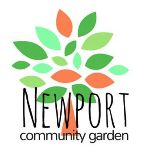 Newport Community Gardens Inc. is a not for profit incorporated association. The garden is in Woolcott Reserve.
Newport Community Gardens Inc. is a not for profit incorporated association. The garden is in Woolcott Reserve.
ObjectivesLocal Northern Beaches residents creating sustainable gardens in public spacesStrengthening the local community, improving health and reconnecting with natureTo establish ecologically sustainable gardens for the production of vegetables, herbs, fruit and companion plants within Pittwater area To enjoy and forge friendships through shared gardening.Membership is open to all Community members willing to participate in establishing gardens and growing sustainable food.Subscription based paid membership.We meet at the garden between 9am – 12 noonNew members welcome
For enquiries contact newportcommunitygardenau@gmail.comFacebook: https://www.facebook.com/pg/newportcg Instagram: https://www.instagram.com/newportcgnsw
 Newport Community Gardens Inc. is a not for profit incorporated association. The garden is in Woolcott Reserve.
Newport Community Gardens Inc. is a not for profit incorporated association. The garden is in Woolcott Reserve.Objectives
Local Northern Beaches residents creating sustainable gardens in public spaces
Strengthening the local community, improving health and reconnecting with nature
To establish ecologically sustainable gardens for the production of vegetables, herbs, fruit and companion plants within Pittwater area
To enjoy and forge friendships through shared gardening.
Membership is open to all Community members willing to participate in establishing gardens and growing sustainable food.
Subscription based paid membership.
We meet at the garden between 9am – 12 noon
New members welcome
For enquiries contact newportcommunitygardenau@gmail.com
Facebook: https://www.facebook.com/pg/newportcg
Instagram: https://www.instagram.com/newportcgnsw
Hendra Virus Confirmed Near Tweed Heads
13 September, 2018: NSW DPIThe NSW Department of Primary Industries (DPI) is urging horse owners to remain vigilant, following confirmation of Hendra virus infection in an unvaccinated horse near Tweed Heads.
NSW Chief Veterinary Officer, Dr Sarah Britton, said the property near Tweed Heads has been placed under movement restrictions by Local Land Services.
“This is the first confirmed case of Hendra virus in NSW this year,” Dr Britton said.
“Samples from the horse were sent by a private veterinarian for laboratory analysis to Queensland’s Biosecurity Sciences Laboratory at Coopers Plains and initial test results confirmed Hendra virus.
“The 4 year old Arab cross was initially noticed by the owner to be lethargic and not eating properly. It deteriorated the next day and was euthanased by a private veterinarian.”
Dr Britton said vaccination of horses is the most effective way to help manage Hendra virus disease.
“Vaccination of horses provides a public health and work health and safety benefit by reducing the risk of Hendra transmission to humans and other susceptible animals," she said.
“Whenever Hendra infection is suspected, even in vaccinated horses, appropriate biosecurity precautions, including personal protective equipment (PPE), should be used.
“Horse owners are encouraged to discuss the option of Hendra vaccination of their horse with their veterinarian.
“Horses should also be kept away from flowering and fruiting trees that are attractive to bats.
“Do not place feed and water under trees and cover feed and water containers with a shelter so they cannot be contaminated from above.”
If your horse in unwell, keep people and animals away from the horse and call your private veterinarian immediately.
If your vet is unavailable you can call a District Veterinarian with the Local Land Services or the Animal Biosecurity Emergency Hotline on 1800 675 888.
For more information about Hendra, visit the NSW DPI website.
13 September, 2018: NSW DPI
The NSW Department of Primary Industries (DPI) is urging horse owners to remain vigilant, following confirmation of Hendra virus infection in an unvaccinated horse near Tweed Heads.
NSW Chief Veterinary Officer, Dr Sarah Britton, said the property near Tweed Heads has been placed under movement restrictions by Local Land Services.
“This is the first confirmed case of Hendra virus in NSW this year,” Dr Britton said.
“Samples from the horse were sent by a private veterinarian for laboratory analysis to Queensland’s Biosecurity Sciences Laboratory at Coopers Plains and initial test results confirmed Hendra virus.
“The 4 year old Arab cross was initially noticed by the owner to be lethargic and not eating properly. It deteriorated the next day and was euthanased by a private veterinarian.”
Dr Britton said vaccination of horses is the most effective way to help manage Hendra virus disease.
“Vaccination of horses provides a public health and work health and safety benefit by reducing the risk of Hendra transmission to humans and other susceptible animals," she said.
“Whenever Hendra infection is suspected, even in vaccinated horses, appropriate biosecurity precautions, including personal protective equipment (PPE), should be used.
“Horse owners are encouraged to discuss the option of Hendra vaccination of their horse with their veterinarian.
“Horses should also be kept away from flowering and fruiting trees that are attractive to bats.
“Do not place feed and water under trees and cover feed and water containers with a shelter so they cannot be contaminated from above.”
If your horse in unwell, keep people and animals away from the horse and call your private veterinarian immediately.
If your vet is unavailable you can call a District Veterinarian with the Local Land Services or the Animal Biosecurity Emergency Hotline on 1800 675 888.
For more information about Hendra, visit the NSW DPI website.
Lock The Gate Questions Legality Of Billions Of Litres Of Rainfall Captured By NSW Coal Mines
September 10, 2018: Media release - Lock the Gate
Revelations on ABC News last night that the Maules Creek coal mine in the state’s North West captured over a billion litres of rainfall it was not licenced to take and use has raised questions about the legality of water capture by the Hunter Valley mining industry.
Lock the Gate referred its investigation into Maules Creek coal mine’s unlicensed take of surface water to the Natural Resources Access Regulator and says it suspects the unlawful take of water is widespread across the coal industry.
According to aggregate figures released by the NSW Minerals Council, the mining industry in the Hunter region extracted 5.7GL from the Hunter River system in 2016, but the industry captured 40GL of rainfall runoff which would otherwise be part of the surface water flow, equivalent to 5.75% of the mean annual flow of the Hunter River at Singleton.
Lock the Gate Alliance spokesperson Georgina Woods said, “The mining industry doesn’t have to pump a lot of water from the river, because it captures rainfall run-off across its huge landholding and uses that water to run the mines.
“The industry’s own figures indicate this captured run-off makes up 55% of the water used by the industry.
“Under NSW water law, landholders are not allowed to catch all the water on their properties for free beyond a basic minimal right. The volume of water being taken in this manner by the coal mines in the Hunter goes for beyond that minimal right and requires licencing because that water is part of the water sharing plans that apply to all water users in the Hunter.
“If the unlawful take of water at Maules Creek is being repeated across the state by the coal mining industry, if the entire coal mining industry is engaging in a blatant legal dodge to take water out of our river systems, then the State Government must act swiftly and decisively.
“In a time of drought, we can’t afford to let the coal mines steal water scot-free. There must be consequences.”
Lock the Gate Alliance will present analysis of the massive capture of rainwater by the coal mining industry at a special hearing this afternoon of the Senate Inquiry into Water Use by the Extractive Industries.
Tough Measures Slug Polluters' Profits
September 7, 2018: NSW EPA
Polluters' profits are being targeted by a new framework that will force environmental offenders to hand over any illegal gains from environmental crime.
NSW is the first state in Australia to implement a robust and transparent calculation method to recover the proceeds of environmental crime from offenders, Environment Minister Gabrielle Upton said.
"Polluters should not be allowed to profit from their environmental offences," Ms Upton said.
"In addition to any fines, the framework will help determine monetary benefits obtained through illegal profits and the avoidance of operating and capital expenditure, including license and waste disposal fees.
"This will be a deterrent to offenders and an incentive for operators to take proper precautions. We want would-be offenders to be aware that there are now major and wider penalties for environmental crime."
"We expect other environmental regulators across Australia to follow our lead and implement similar approaches to recovering monetary benefits through the courts," Ms Upton said.
Under the changes, the NSW Environment Protection Authority can apply to the Court for a monetary benefits order as part of the sentencing package. These orders strip offenders of illegal profits made by committing an offence.
"There is now a clear and transparent method for calculating the amount of the illegal profit that offenders should pay back. It is a fundamental principle that offenders should not profit from crime," Ms Upton said.
Background
Monetary benefits are the financial advantage that an offender gains from avoiding or delaying spending money on complying with environmental legislation.
The EPA has now developed an approach for calculating and recovering monetary benefits for appropriate cases, which can be used under the Protection of the Environment Operations Act 1997.
Examples of Monetary Benefits that can be gained by breaching EPA requirements
A quarry exceeds its annual extraction limit. From the additional sales, it makes $650,000 in illegal profits and avoid $20,000 in extra licensing fees.
A waste contractor illegally dumps asbestos waste, avoiding $10,000 in disposal costs.
A chemical manufacturing company fails to install a bund (barrier) around a faulty storage tank and other storage tanks on site. By not installing the bunds, the company avoids $220,000 in capital costs. The company also does not have a Pollution Incident Response Management Plan nor does it train staff in responding to pollution incidents, avoiding $15,000 in operational costs.
A landowner operates an illegal waste facility for two years and makes $500,000 in illegal profits by charging for the waste. The landowner also avoids $150,000 in operational costs by not paying for the development consent process, consultancy fees and annual licensing fees. It also failed to install appropriate pollution control measures, avoiding $300,000 in capital costs.
A cement manufacturer avoided $60,000 in operational costs by not maintaining an air filtration unit. The unit failed and caused air pollution.
Fresh New Look For Sydney’s Martin Place
September 12, 2018: NSW Government
Better access to public transport, upgraded public spaces and new commercial buildings will be part of the Martin Place station redevelopment.
Macquarie Group will deliver the $378.6 million integrated station development. The Sydney Metro will open in Martin Place in 2024.
Martin Place station and the integrated station development will be built at the same time to reduce any impact to the community. Lendlease will design, construct and deliver the new development.
It will meet the same high standards as all the new city metro stations and will be owned by the NSW Government.
Once completed, customers will walk past a range of stores on their way to the train station. The modern design has been informed by New York’s World Trade Centre station and Hong Kong’s International Finance Centre.
Minister for Transport and Infrastructure Andrew Constance said the integrated development coupled with the Sydney Metro in the CBD will breathe new life into the heart of the city.
“As part of our plan to improve public transport, new metro rail will help give people more choice on how they get around Sydney,” Mr Constance said.
“With the new Martin Place Station, customers in the heart of Sydney’s CBD will have access to an unprecedented level of public transport and will be more connected than ever before.”
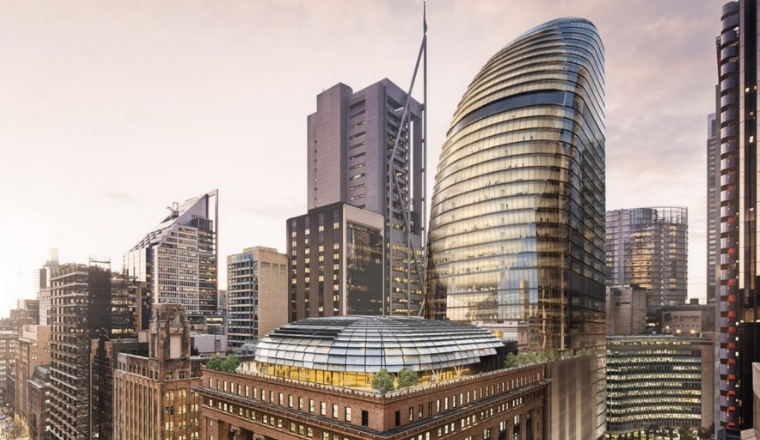
Western Sydney Aerotropolis Will Be Home To Major New University
September 13, 2018: The Hon. Gladys Berejiklian, Premier of NSW
Four of NSW’s leading universities are joining forces to create a world-class, higher education institution in the heart of the new Western Sydney Aerotropolis.
The project – an Australian first – will have a clear focus on science, technology, engineering and mathematics (STEM) education, ensuring that young people in Western Sydney are ready for the jobs of tomorrow.
Vice Chancellors from the University of Newcastle, University of NSW and University of Wollongong (the NUW Alliance), and Western Sydney University, have signed a Statement of Intent with the NSW Government to deliver the new higher education institution.
“The NSW Government is working hard to create more jobs in every part of NSW and the Western Sydney Aerotropolis will create thousands of employment opportunities for young people,” Premier Gladys Berejiklian said.
“The jobs of tomorrow will rely heavily on science, technology, engineering and mathematics, so I applaud this great initiative. It will ensure students in Western Sydney have even greater access to world-class higher education.”
Minister for Western Sydney Stuart Ayres added, “Quality jobs are built on a foundation of quality education. This education alliance is exactly what the Western Sydney Aerotropolis needs to be a jobs powerhouse of the future.”
The project builds on the significant momentum already made on the Western Sydney Aerotropolis.
In May, Ms Berejiklian hosted the Aerotropolis Investor Forum in Western Sydney, with more than 250 local and international business leaders seeking to secure their place at the 10,000-hectare greenfield site around Western Sydney Airport.
With a 24-hour international airport at its core, the Western Sydney Aerotropolis will be a thriving hub for education and leading industries including advanced manufacturing, aerospace, defence and agribusiness, generating a huge high-skill jobs boost for the area.
Located in the new Aerotropolis precinct, the four universities will create one campus. Students at the new institution will have unparalleled access to industry research, development and employment opportunities.
“The university project we have announced today is the first of its kind in Australia and the first new university built in Sydney in 50 years,” Ms Berejklian said.
“This will transform Western Sydney for generations to come.”
“It will be a world-class institution bringing together the best and brightest educators to develop our state’s future scientists, engineers, and mathematicians.”
“Stage One of the new university will be open by 2026, the same time the new $5.3 billion Commonwealth funded airport is expected to be operational.”
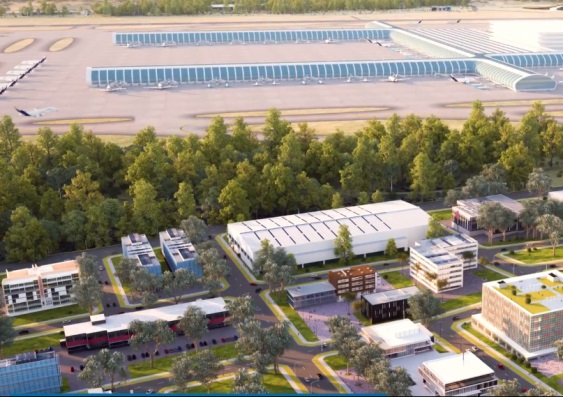
An artist's impression of part of the Aerotropolis development. Image: www.planning.nsw.gov.au
In an Australian first, the NUW Alliance (the University of Newcastle, UNSW Sydney and the University of Wollongong) and Western Sydney University will join forces to deliver a world-class higher education and research presence in Western Sydney.
The Multiversity will specialise in STEM (science, technology, engineering and mathematics) and be part of the Aerotropolis precinct at Badgerys Creek. By leveraging the expertise of the four institutions, students, employees and the wider community will have unparalleled access to innovative teaching and research.
Acting Vice-Chancellor Professor Kevin Hall (UoN); President and Vice-Chancellor Professor Ian Jacobs (UNSW); Acting Vice-Chancellor Professor Judy Raper (UOW); and Vice-Chancellor and President Barney Glover (WSU), have signed a Statement of Intent with the NSW government to deliver the new higher education institution.
In a statement, the Vice-Chancellors collectively highlighted the strengths of the multiversity proposition:
“Higher education has traditionally been an intensely competitive sector. With the new Multiversity, our universities are demonstrating how collaborative university partnerships can transform the region and produce the graduates, research and industry links needed to make the Aerotropolis a success.”
The four universities will create one campus with strong links to local industry, tailored vocational education and training, and STEM-focused schooling. This will provide the foundation for the realisation of the government’s knowledge job creation commitments.
“This is an unrivalled opportunity to place our world-class universities at the heart of what is surely the biggest and boldest project Australia has seen, or will see, for a very long time. Our universities bring a connected network of 180,000 students, researchers and academics to the Aerotropolis, with an established presence across every major Western Sydney centre,” the Vice-Chancellors’ statement said.
With a 24-hour international airport at its core, the Western Sydney Aerotropolis will be a thriving hub for education and leading industries including advanced manufacturing, aerospace, defence and agribusiness, generating a jobs boost for the area.
Environmental Approvals Pave The Way For Parkes To Narromine Inland Rail Construction
MEDIA RELEASE: 05 September 2018
JOINT RELEASE WITH:
Senator the Hon Mathias Cormann
Minister for Finance and the Public Service
Senator for Western Australia
The Hon Melissa Price MP
Minister for the Environment
Federal Member for Durack
The Hon Mark Coulton MP
Assistant Minister for Trade, Tourism and Investment
Federal Member for Parkes
The Hon Melinda Pavey MP
NSW Minister for Roads, Maritime and Freight
State Member for Oxley
The Hon Anthony Roberts MP
NSW Minister for Planning
State Member for Lane Cove
The Australian and New South Wales Governments have given the green light for construction to commence on the Parkes to Narromine section of Inland Rail.
Deputy Prime Minister, Nationals’ Leader and Minister for Infrastructure, Transport and Regional Development Michael McCormack said Inland Rail will bring jobs and opportunities, improve connectivity and increase freight productivity for businesses and consumers in regional Australia.
“Today is another vital step in making our Inland Rail vision a reality and I am excited for the first section of Inland Rail construction to commence, with $9.3 billion in Federal Government investment,” Mr McCormack said.
“Communities across regional Victoria, New South Wales and Queensland will see the benefit of better access to markets at home and overseas, as well as ensuring Australia meets the challenge of our freight task which is set to double.”
Minister for Finance and the Public Service Mathias Cormann said Inland Rail will be a corridor of commerce for communities along the Eastern Seaboard.
“Through this investment, the Australian Government is delivering on its commitment to increase freight productivity, ease road congestion and streamline supply chains for businesses and consumers,” Senator Cormann said.
Minister for the Environment Melissa Price said final approval for these works under the Environment Protection and Biodiversity Conservation Act was provided by the Department of the Environment and Energy this week.
“The Australian Rail Track Corporation (ARTC) can start its upgrade to the 106 kilometres of track between these two important regional service centres. This will bring jobs and economic opportunity to the region,” Ms Price said.
Federal Member for Parkes Mark Coulton said he was pleased to see regional Australians are ready for Inland Rail.
“Inland Rail was what made me get off the tractor and put my hand up for Parliament—this is going to be a transformational investment in communities throughout Western NSW,” Mr Coulton said.
“Whether it’s seeing firsthand the opportunities for greater market access as Australia’s Assistant Trade Minister or understanding the passion local farmers and small businesses have for new jobs and opportunities in Western NSW, this is an exciting project.”
NSW Minister for Roads, Maritime and Freight Melinda Pavey welcomed the next step toward making the Parkes to Narromine section a reality.
“The capacity to move freight efficiently and reliably is the single most important factor in ensuring the continued health of our domestic economy, and in growing and maintaining economic competitiveness,” Mrs Pavey said.
NSW Minister for Planning and Housing Anthony Roberts said approval for these works under the NSW Environmental Planning and Assessment Act was provided by the New South Wales Department of Planning and Environment previously.
“I’m pleased to see both Governments give the green light for the first Inland Rail project to begin,” Mr Roberts said.
“Our freight network supports economic growth in New South Wales, however the existing freight rail line is constrained as it travels through the congested Sydney network, bypassing some of the state’s most productive agricultural regions.”
The ARTC has been appointed by the Australian Government to deliver Inland Rail in partnership with the private sector.
More information about the Inland Rail project is available at infrastructure.gov.au/rail/inland/ and epbcnotices.environment.gov.au/publicnoticesreferrals/.
Disclaimer: These articles are not intended to provide medical advice, diagnosis or treatment. Views expressed here do not necessarily reflect those of Pittwater Online News or its staff.